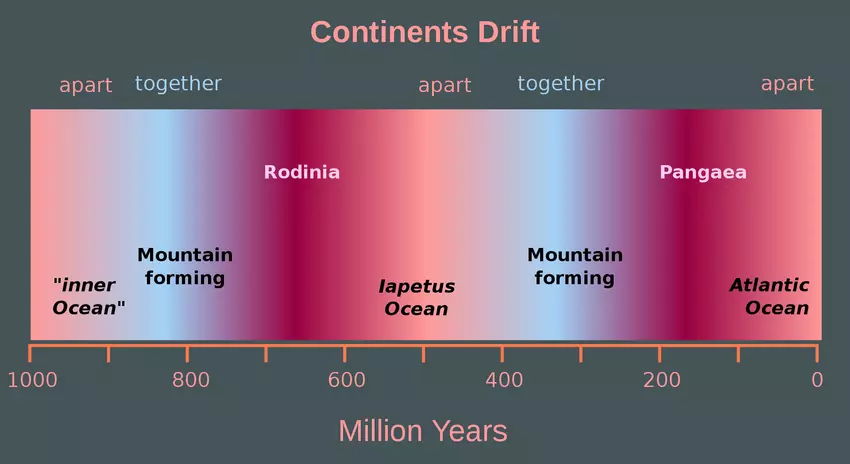- The plate tectonic theory says that Earth’s surface is made up of slabs of rock that are slowly shifting right under our feet.
- Because of this constant movement, today’s Earth looks a lot different from what it did millions of years ago.
- In 1912, German scientist Alfred Wegener proposed that Earth’s continents once formed a single, giant landmass, called Pangaea.
- Over millions of years, Pangaea slowly broke apart, eventually forming the continents as they are today.
- The video below shows how this happened over one billion years.
1 billion years of tectonic plate movement in 40 seconds
According to plate tectonic theory, the Earth’s surface is made up of slabs of rock that are slowly shifting right under our feet.
Because of this constant movement, today’s Earth looks a lot different from what it did millions of years ago. Today’s animation looks at the Earth’s tectonic plate movement from 1 ga (geological time for 1 billion years ago) to the present-day, via EarthByte on YouTube.
Editor’s note: The video starts at time 1,000 ma (1,000 million years ago), and ticks down at the rate of about 25 million years every second.
The emergence of plate tectonic theory
Plate tectonics is a relatively new theory—in fact, according to National Geographic, it hadn’t become popular until the 1960s. However, the concept of continental movement was brewing long before it became widely accepted.
In 1912, German scientist Alfred Wegener proposed a theory he called continental drift. According to Wegener’s theory, Earth’s continents once formed a single, giant landmass, which he called Pangaea.
Over millions of years, Pangaea slowly broke apart, eventually forming the continents as they are today. Wegener believed this continental drift explained why the borders of South America and Africa looked like matching puzzle pieces. He also pointed to similar rock formations and fossils on these two continents as proof to back his theory.
Initially, the scientific community wasn’t on board with the theory of continental drift. But as more data emerged over the years, including research on seafloor spreading, the theory started to gain traction.
The supercontinent cycle
Nowadays, it’s believed that Pangea was just one of several supercontinents to mass together (and break apart) over the course of geological history.
The exact number of supercontinents is largely debated, but according to the Encylopedia of Geology, here are five (including Pangea) that are widely recognized:
Kenorland: 2.7-2.5 billion years ago
Nuna/Columbia: 1.6-1.4 billion years ago
Rodinia: 950–800 million years ago
Pannotia: 620-580 million years ago
Pangea: 325-175 million years ago
According to the theory, this cycle of breaking apart and coming together happens because of subduction, which occurs when tectonic plates converge with one another.
The supercontinent cycle also ties into ocean formation. The below example of the Wilson Cycle specifically keys in on how the Atlantic Ocean, and its predecessor, the Iapetus Ocean, were formed as supercontinents drifted apart:
The importance of plate tectonics
Plate tectonics has been a game-changer for geologists. The theory has helped to explain tons of unanswered geological questions, assisting scientists in understanding how volcanoes, mountains, and ocean ridges are formed.
Since the theory of plate tectonics is relatively new, there’s still a lot to be discovered in this field of research. However, in March 2021, a report was published in Earth-Science Reviews that, for the first time, visualized a continuous plate model that shows how Earth’s plates have shifted over the last billion years.
The video above visualizes this particular report and accurately depicts the Earth’s tectonic plates’ movement or the observed shift in Earth’s tectonic plates over the years.
https://www.weforum.org/agenda/2021/07/1-billion-years-tectonic-plate-movement-pangaea-geology
![]()


